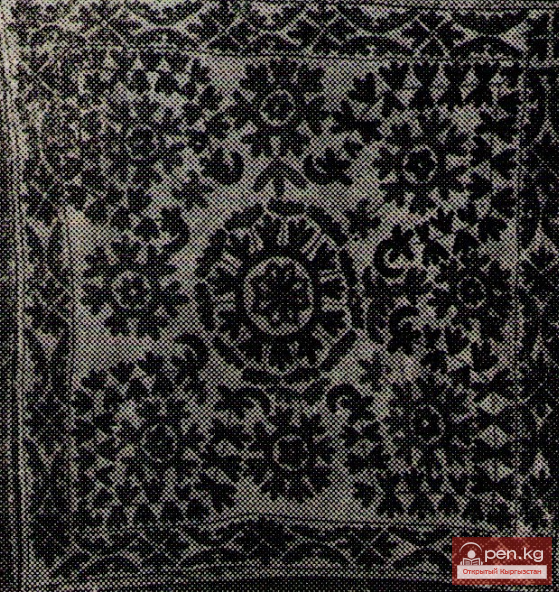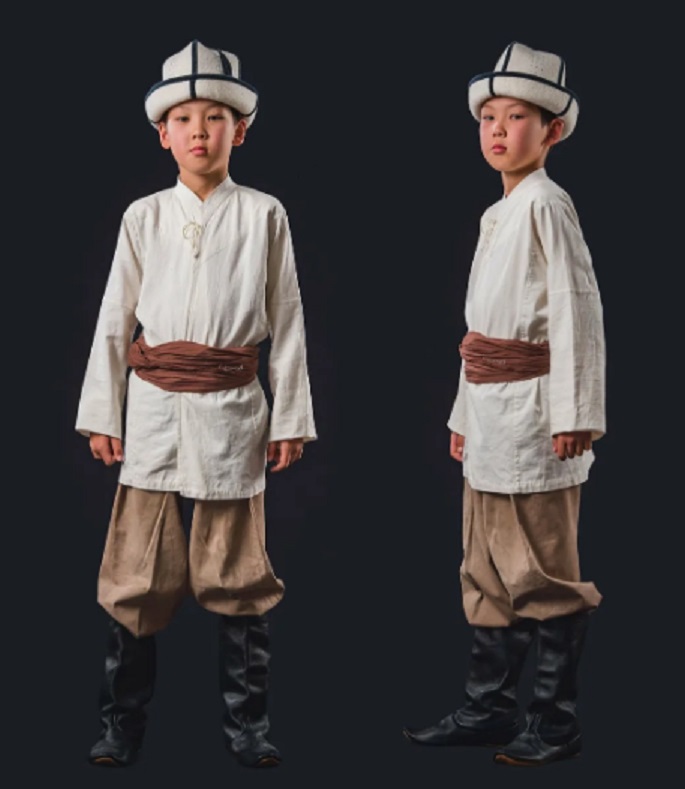
Embroiderers
The material on which southern Kyrgyz people embroidered is quite diverse. It includes leather, felt, fabric made of wool or cotton, silk or cotton braid woven by hand, on small looms, or on boards. Purchased materials were also widely used: fabrics of artisanal Central Asian or Kashgar production, and with the increase in the import of factory-made fabrics into Central Asia in the 1980s and 1990s — red cloth (manat), black velvet (barkut, bakhmal), which were especially highly valued and accessible to more affluent families. Later, colored satin (red, blue, yellow), red flannel, and calico became popular.
For the ichkiliks, embroidery on light material was characteristic. For this, they tanned goat and sheep skins; later, they began to use tightly woven white fabrics made at home (for embroidering household bags, curtains for the yurt door). These embroideries differed from those of Kyrgyz people from other tribal groups and had a great resemblance to Uzbek ones.
Kyrgyz people used woolen, paper, and silk threads of various thicknesses and colors depending on the nature of the embroidery. Woolen threads were made from sheep's wool and goat down. Thin woolen threads were also purchased for embroidering women's headwear. In the market, Kyrgyz people bought raw silk produced by artisans, as well as cotton factory threads imported from Russia. The latter were highly valued by embroiderers (they called them parang jip).
Before use, craftswomen usually processed the threads: they twisted them tightly on a spindle and then cleaned them of knots using a thick needle or a thin stick, more often a chia stem. The processed thread is called zhylma jip, i.e., a thread without roughness, smooth.
Old Kyrgyz embroideries are characterized by a limited combination of colors. In embroideries made with woolen threads prepared by embroiderers, the favorite Kyrgyz colors were used — red, crimson, blue, green, as well as white and yellow. The use of purchased threads and aniline dyes changed the color palette of Kyrgyz embroideries, introducing many other colors, including violet.

This is especially noticeable in embroideries on light material. It should be noted that when selecting colored threads for embroidery, craftswomen exhibit a great sense of measure. There is neither extreme brightness nor dullness in Kyrgyz embroideries. An artistic selection of the color palette and strict consistency of tones is observed. Although contrasting color combinations are characteristic for Kyrgyz embroidery on a black background, a calm soft tone with a predominance of red is common. White and yellow colors are introduced to fill in some detail of the ornament.
In modern embroideries, silk threads and mouliné are widely used. Bright colors are preferred, especially shades of red.
Craftswomen usually embroider while sitting on the floor, tucking their left leg under themselves and bending their right knee. For convenience, the fabric is pinned to their dress at the knee. Hoops, which are widely used by northern Kyrgyz, are not used in the south. Just like in regular sewing, they work with a thimble (oymok), which looks like a ring with a shield.
It is worn on the tip of the index finger of the right hand, which is used to push the needle through. While embroidering, good craftswomen always guide and twist the thread with the thumb and index finger of their left hand with each stitch, thereby giving density to the embroidery.
Among embroiderers, there are craftswomen who can apply the outlines of patterns to the fabric being embroidered. Many women seek their help, as not everyone possesses this skill. The craftswomen usually draw without a template, habitually applying lines with a pointed stick. On light material, they draw with paint diluted in water, and on black — with a solution of salt or flour.
Skilled craftswomen are well-known among the people: Interestingly, there is a kind of "age specialization" among them. We have encountered wonderful craftswomen of advanced age who are extremely devoted to their work but only master the old stitches. Conversely, good young craftswomen do not know the stitches used in previous embroidery and only embroider with modern ones.
According to some elderly craftswomen, in the past they earned money through embroidery, accepting orders and receiving various products for their labor.
Craftswoman Sharapat Madymarova (born 1900, village of Sogment, Batken district) learned to embroider in childhood. Her grandmother and mother were remarkable embroiderers. From them, she inherited the national traditions of embroidery, love for work, and the ability to use her leisure time. After marriage, she began to embroider to order.
Sharapat primarily embroidered pillowcases on velvet, saddle blankets, and sashes.
In addition to the art of embroidery, Sharapat knows patterned weaving, appliqué work, and can weave lace, braid, cords, etc. She now passes her knowledge to her daughter-in-law.
Gulbyu Bataeva (born 1890, village of Ak-Kiya, Soviet district) has almost the same biographical details. However, in her youth, she mainly embroidered on felt and velvet (wall carpets and wrap skirts).
Among the best embroiderers, we should also mention Zamiрат Khudaybergenova (born 1913, village of Batken), who is unfamiliar with embroidery on felt and leather. She embroiders on velvet and white fabric.
Young embroiderer Aynisa Abduadieva (born 1940, village of Japalak, Osh district) is engaged in embroidery of a completely different nature: she embroiders towels, curtains for hangers, and strips that decorate the walls of the room. She is unfamiliar with old stitches.
Embroidery - a widespread form of Kyrgyz folk art in the past














































